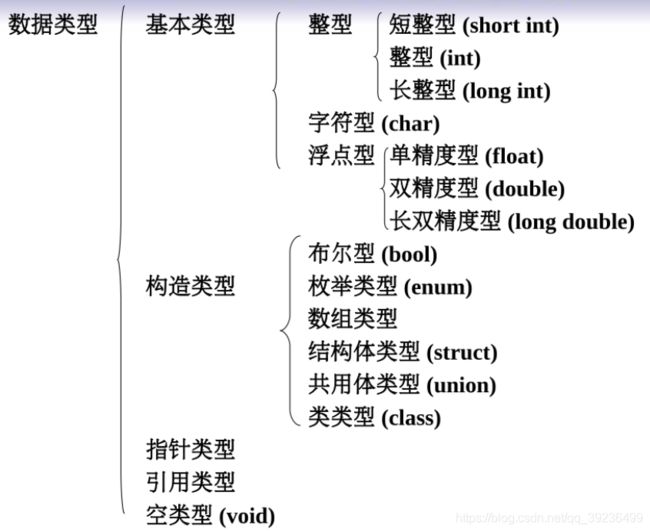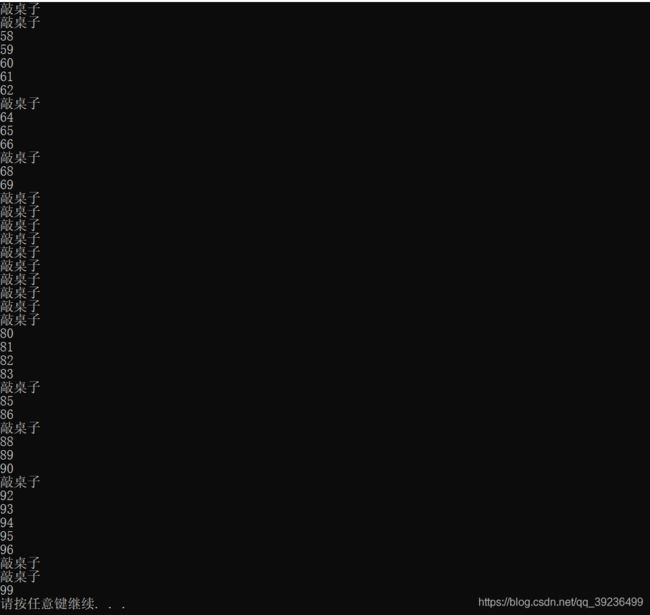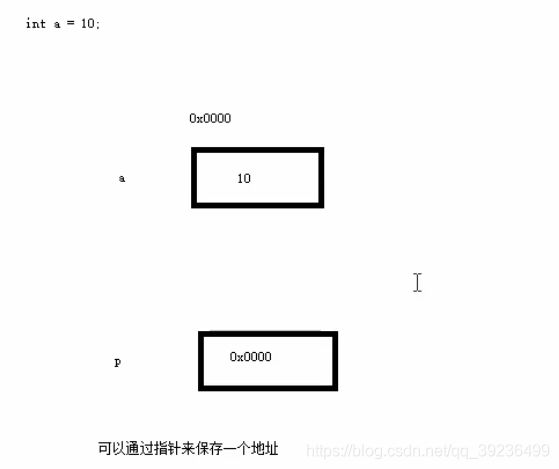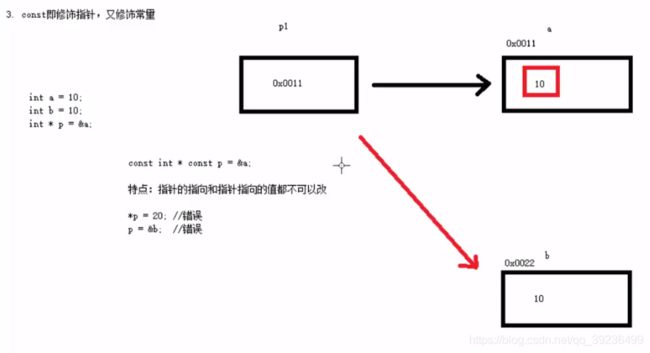C++入门详细笔记(共八章)
文章目录
-
- 第一章 C++初识
-
- 1.1 第一个C++程序
- 1.2 注释:(1)单行注释、(2)多行注释
- 1.3 变量
- 1.4 常量:(1)#define 宏常量、(2)const修饰的变量
- 1.5 关键字
- 1.6 标识符命名规则
- 第二章 数据类型
-
- 2.1 整型:(1)short、(2)int、(3)long、(4)long long
- 2.2 sizeof关键字
- 2.3 实型(浮点型):(1)单精度float、(2)双精度double
- 2.4 字符型
- 2.5 转义字符
-
- 1. 换行符 \n
- 2. 反斜杠 \ \
- 3.水平制表符 \t
- 2.6 字符串型
-
- 1. C风格字符串
- 2. C++风格字符串
- 2.7 布尔类型 bool
- 2.8 数据的输入
- 第三章 运算符
-
- 3.1 算数运算符
-
- 1. 除 /
- 2. 求余 %
- 3. a++ 和 ++a
- 3.2 赋值运算符
- 3.3 比较运算符
- 3.4 逻辑运算符
- 第四章 程序流程结构
-
- 4.1 选择结构
-
- 4.1.1 if语句
- 4.1.2 三目运算符
- 4.1.3 switch语句
- 4.2 循环结构
-
- 4.2.1 while循环语句
-
- 练习案例:猜数字小游戏
- 4.2.2 do...while循环语句
-
- 练习案例:水仙花数
- 4.2.3 for循环语句
-
- 练习案例:敲桌子
- 4.2.4 嵌套循环
-
- 练习案例:九九乘法表
- 4.3 跳转语句
-
- 4.3.1 break语句
- 4.3.2 continue语句
- 4.6.3 goto语句
- 第五章 数组array
-
- 5.1 概述
- 5.2 一维数组
-
- 5.2.1 一维数组定义方式
- 5.2.2 一维数组数组名
-
- 练习案例1:五只小猪称体重
- 练习案例2:数组元素逆置
- 5.2.3 冒泡排序
- 5.3 二维数组
-
- 5.3.1 二维数组的定义方式
- 5.3.2 二维数组的数组组名
- 5.3.3 二维数组应用案例
- 第六章 函数
-
- 6.1 概述
- 6.2 函数的定义
- 6.3 函数的调用
- 6.4值传递
- 6.5 函数的常见样式
- 6.6 函数的声明
- 6.7 函数的分文件编写
- 第七章 指针
-
- 7.1 指针的基本概念
- 7.2 指针变量的定义和使用
- 7.3 指针所占内存空间
- 7.4 空指针和野指针
- 7.5 const修饰指针
- 7.6 指针和数组
- 7.7 指针和函数
- 7.8 指针、数组、函数
- 第八章 结构体
-
- 8.1 结构体基本概念
- 8.2 结构体定义和使用
- 8.3 结构体数组
- 8.4 结构体指针
- 8.5 结构体嵌套结构体
- 8.6 结构体做函数参数
- 8.7 结构体中const使用场景
- 8.8 结构体案例
-
- 8.8.1 案例1
- 8.8.2 案例2
- 8.8.3 案例3:通讯录管理系统
本博客配套视频:黑马程序员
本博客参考博客:https://blog.csdn.net/sunshine_world/article/details/107688106
第一章 C++初识
1.1 第一个C++程序
框架
#include 书写hello world
#include hello world
请按任意键继续. . .
错误示例:单引号不行,这里不像Python
cout << 'hello world' << endl;
1.2 注释:(1)单行注释、(2)多行注释
1. 单行注释
// 注释内容
2. 多行注释
/* 注释内容 */
1.3 变量
作用:给一个指定的内存空间起名,方便操作这段内存
语法:数据类型 变量名 = 初始值;
#include a=10
请按任意键继续. . .
注意:C++在创建变量时,必须给变量一个初始值,否则会报错
1.4 常量:(1)#define 宏常量、(2)const修饰的变量
作用:用于记录程序中不可更改的数据
两种定义方法:
1. #define 宏常量
#define 常量名 常量值
- 一般定义在代码的上方,结尾不需要分号
#define Day 7 //意思就是Day以后就代表7
例:
#include 2. const修饰的变量
const 数据类型 常量名 = 常量值
- 通常在变量定义前加 const,修饰该变量为常量
注意:需要分号结尾
//const修饰的变量也称为常量
const int day = 7;
例
#include 一周共有多少天:7
请按任意键继续. . .
1.5 关键字
作用: C++中预先保留的单词(标识符)
错误示例:int不能作为变量名
int int = 10;
注意:在给变量或者常量起名称时候,不要用C++得关键字,否则会产生歧义
1.6 标识符命名规则
作用:C++规定给标识符(变量、常量)命名时,有一套自己的规则
- 1.标识符不能是关键字
int int =10; //错误示例
- 2.标识符只能有字母,数字,下划线组成
int abc = 10;
int _abc = 20;
int _123abc = 30;
- 3.第一个字符必须为字母或下划线,不能是数字
//int 123abc = 30; //错误
- 4.标识符字母区分大小写
int aaa = 40;
int AAA = 50;
建议:给标识符命名时,争取做到见名知意的效果,方便自己和他人的阅读
第二章 数据类型
C++规定在创建一个变量或者常量时,必须要指定初相应的数据类型,否则无法给变量分配内存
2.1 整型:(1)short、(2)int、(3)long、(4)long long
作用:整形变量表示的是整数类型的数据
注意:
- 整型数据是按二进制数形式存储
- 在整型符号int和字符型符号char的前面,可以加修饰符signed(表示有符号)或unsigned(表示无符号)。如果指定signed,则数值以补码形式存放;如果指定为unsigned,则数值没有符号,全部二进制位都用来表示数值本身。

以下集中都能表示整型,区别在于所占用内存空间不同:

一般使用int即可
#include -32768
32768
10
10
请按任意键继续. . .
2.2 sizeof关键字
作用:统计数据类型所占内存大小
语法:sizeof(数据类型/ 变量)
#include short占用的内存空间为:2
short占用的内存空间为:2
int占用的内存空间为:4
long占用的内存空间为:4
long long占用的内存空间为:8
请按任意键继续. . .
2.3 实型(浮点型):(1)单精度float、(2)双精度double
作用: 用于表示小数
浮点型变量有两种:单精度float、双精度double
1. 单精度float
默认情况下输出一个小数会显示6位有效数字
int main()
{
//默认情况下输出一个小数会显示6位有效数字
float f1 = 3.14f; //通常在float后面多加一个f
cout << "f1=" << f1 << endl;
float f2 = 3.1415926f;
cout << "f2=" << f2 << endl;
system("pause");
return 0;
}
f1=3.14
f2=3.14159
请按任意键继续. . .
2. 双精度double
#include d1=3.14
d2=3.14159
请按任意键继续. . .
例2:统计占用的内存空间
#include float占用的内存空间为:4
double占用的内存空间为:8
请按任意键继续. . .
例3:科学计数法
#include f2=300
f3=0.03
请按任意键继续. . .
2.4 字符型
作用:可以表示单个字母的数据类型
语法:char ch = 'a';
注意1:单引号,不是双引号
char ch = 'a';
// char ch2 = "b" 双引号错误
注意2:单引号里面只能写一个字符,不能写字符串
// char ch2 = 'abcd' 单引号内只能有一个字符
- C和C++中字符型变量只占用1个字节
- 字符型变量并不是把字符本身放到内存中存储,而是将对应的ASCII码放入对应的存储单元
例1:
#include char字符型变量所占用内存1
请按任意键继续. . .
例2:
比如a对应97,所以存储97
#include 97
请按任意键继续. . .
2.5 转义字符
作用:用于表示一些不能显示出来的ASCII字符
现阶段我们常用的转义字符有: \n \ \t

1. 换行符 \n
#include hello
world请按任意键继续. . .
2. 反斜杠 \ \
#include hello\world
请按任意键继续. . .
3.水平制表符 \t
#include 宽度一共八个,前面有n个a,后面就8-n个空格
aaa hello
aa hello
aaaa hello
请按任意键继续. . .
2.6 字符串型
作用:用于表示一串字符
两种风格:
1. C风格字符串
char 变量名[] = "字符串值";
#include str1=abc
请按任意键继续. . .
注意:C风格的字符串要用双引号括起来
2. C++风格字符串
string 变量名 = "字符串值";
注意:老版本可能需要包含string头文件
#include 2.7 布尔类型 bool
作用:布尔值数据类型代表真或假的值
- true
- false
bool类型占1个字节
#include 1
bool类型所占用空间1
2.8 数据的输入
作用:用于从键盘获取数据
关键字:cin
语法:cin >> 变量
例1:整型赋值
#include 请给整形变量a赋值:
12
赋值后a为:12
请按任意键继续. . .
例2:浮点型赋值
#include 请给浮点型f赋值:
3.1415
赋值后f为:3.1415
请按任意键继续. . .
例3:字符型
#include 请给字符型ch赋值:
b
赋值后ch为:b
请按任意键继续. . .
例4:字符串型
#include 请给字符串str1,str2赋值:
abcd
abcde
赋值后str1为:abcd
赋值后str2为:abcde
请按任意键继续. . .
例5:bool类型
除了0代表假,其他都为真
#include 请给bool类型flag赋值:
2020
赋值后:1
请按任意键继续. . .
请给bool类型flag赋值:
3.14
赋值后:1
请按任意键继续. . .
第三章 运算符
3.1 算数运算符
1. 除 /
例1:整数相除只输出整数
#include 3
0
请按任意键继续. . .
注意:除数不能为0
错误示例:
int a1 = 10;
int b1 = 0;
//cout << a1 / b1 << endl;
例2:小数相除,除不尽则输出小数
#include 2.5
2
请按任意键继续. . .
2. 求余 %
注意:两个小数不能取模
总结:只有整型变量可以进行取模运算
#include 1
10
请按任意键继续. . .
3. a++ 和 ++a
++a:前置递增 先让变量+1 然后进行表达式的运算
a++:后置递增 先进行表达式的运算 后让变量+1
#include a=11
b=11
a2=11
b2=110
a3=11
b3=100
请按任意键继续. . .
3.2 赋值运算符
作用:用于将表达式的值赋给变量

这里是和Python一样的,例如:
a+=2意思就是a=a+2,其他运算符一个意思。
3.3 比较运算符
作用:用于表达式的比较,并返回一个真值或假值
#include 1
1
0
请按任意键继续. . .
3.4 逻辑运算符
作用:用于根据表达式的值返回真值或假值
#include 0
1
1
1
请按任意键继续. . .
第四章 程序流程结构
C++支持最基本的三种程序运行结构:顺序结构、选择结构、循环结构
- 顺序结构:程序按顺序执行,不发生跳转
- 选择结构:依据条件是否满足,有选择的执行相应功能
- 循环机构:依据条件是否满足,循环多次执行某段代码
4.1 选择结构
4.1.1 if语句
四种形式:
- 单行格式if语句
- 多行格式if语句
- 多条件if语句
- 嵌套if语句
#include 请输入分数:
92
a
请按任意键继续. . .
注意:if条件表达式后不要加分号
例2:多行格式
格式:if(条件){条件满足执行的语句}else{条件不满足执行的语句}

#include 请输入分数:
89
b
请按任意键继续. . .
例3:多条件if语句
格式:if(条件1){条件1满足执行的语句}else if(条件2){条件2满足执行的语句} ... else{都不满足执行的语句}

#include 请输入分数:
62
d
请按任意键继续. . .
例4:嵌套if语句
#include 请输入分数:
92
恭喜你及格了
你的等级为a
请按任意键继续. . .
#include 请输入小猪a的体重:
150
请输入小猪b的体重:
200
请输入小猪c的体重:
300
小猪c最重
请按任意键继续. . .
4.1.2 三目运算符
作用:通过三目运算符实现简单的判断
语法:表达式1 ? 表达式2 : 表达式3
解释:
- 如果表达式1的值为真,执行表达式2,并返回表达式2的结果
- 如果表达式1的值为假,执行表达式3,并返回表达式3的结果
#include c=20
a=10
b=100
请按任意键继续. . .
4.1.3 switch语句
执行多条件分支语句
语法:
switch(表达式)
{
case 结果1:执行语句; break;
case 结果2:执行语句; break;
...
default:执行语句; break;
}
例:
#include 请输入分数:
5
f
请按任意键继续. . .
if和switch的区别:
- switch缺点:判断时候只能是整型或字符型,不可以是一个区间
- switch优点:结构清晰,执行效率高
4.2 循环结构
4.2.1 while循环语句
作用:满足循环条件,执行循环语句
语法:while(循环条件) {循环语句}
#include 1
2
3
4
5
6
请按任意键继续. . .
例2
int main()
{
int j = 0;
int m = 0;
while (j <= 5)
{
m = j++;
cout << m << endl;
}
system("pause");
return 0;
}
0
1
2
3
4
5
请按任意键继续. . .
练习案例:猜数字小游戏
rand()用法:
rand()%100 //随机生成数 0~99
例:
#include 请输入数字:
52
猜测过大
请输入数字:
26
猜测过小
请输入数字:
45
猜测过大
请输入数字:
40
猜测过小
请输入数字:
42
恭喜你猜对了
请按任意键继续. . .
可是这个版本每次运行程序生成的随机数是固定的,下次再运行程序直接猜对
请输入数字:
42
恭喜你猜对了
请按任意键继续. . .
例2:解决方法: #include < ctime>
#include 产生的随机数再也不是42了
请输入数字:
42
猜测过小
请输入数字:
56
猜测过小
请输入数字:
78
猜测过大
请输入数字:
70
猜测过大
请输入数字:
65
猜测过小
请输入数字:
67
猜测过小
请输入数字:
69
猜测过大
请输入数字:
68
恭喜你猜对了
请按任意键继续. . .
4.2.2 do…while循环语句
语法:do{循环语句] while(循环条件);
注意:与while的区别在于do…while会先执行一次循环语句,再判断循环条件

#include 0
1
2
3
4
5
6
7
8
9
请按任意键继续. . .
练习案例:水仙花数
案例描述:水仙花数是指一个3位数,它的每个位上的数字的3次幂之和等于它本身
例如:1^3 + 5^3 + 3^3 =153
请利用do…while语句,求出所有33位数的水仙花数
#include 153
370
371
407
请按任意键继续. . .
注意:这里不可以打
n == a ^ 3 + b ^ 3 + c ^ 3;
4.2.3 for循环语句
作用:满足循环条件,执行循环语句
语法:for(起始表达式;条件表达式;末尾表达式){循环语句};
#include 0
1
2
3
4
5
6
7
8
9
请按任意键继续. . .
注意:for循环中的表达式,要用分号进行分隔
例2
#include 0
1
2
3
4
5
6
7
8
9
请按任意键继续. . .
练习案例:敲桌子
案例描述:从1开始数到数字100, 如果数字个位含有7,或者数字十位含有7,或者该数字是7的倍数,我们打印敲桌子,其余数字直接打印输出。

#include 4.2.4 嵌套循环
#include 练习案例:九九乘法表
#include 4.3 跳转语句
4.3.1 break语句
作用:用于跳出选择结构或者循环结构
break使用的时机:
- 出现在switch条件语句中,作用是终止case并跳出switch
- 出现在循环语句中,作用是跳出当前的循环语句
- 出现在嵌套语句中,跳出最近的内层循环语句
例1:switch语句中
#include 请选择副本难度
1、普通
2、中等
3、困难
1
您选择的是普通难度
请按任意键继续. . .
例2:在for循环中
#include 0
1
2
3
4
请按任意键继续. . .
例3:在嵌套for循环中退出内层循环
#include 4.3.2 continue语句
作用:在循环语句中,跳过本次循环中余下尚未执行的语句,继续执行下一次循环
#include 0
1
2
3
4
6
7
9
请按任意键继续. . .
注意:continue并没有使整个循环终止,而break会跳出循环
4.6.3 goto语句
作用:可以无条件跳转语句
语法:goto 标记
解释:如果标记的名称存在,执行到goto语句时,会跳转到标记的位置
#include 1
5
请按任意键继续. . .
注意:在程序中不建议使用goto语句,以免造成程序流程混乱
第五章 数组array
5.1 概述
所谓数组,就是一个集合,里面存放了相同类型的数据元素
特点1:数组中每个元素都是相同的数据类型
特点2:数组是由连续的内存位置组成的
5.2 一维数组
5.2.1 一维数组定义方式
一维数组定义的三种方式:
1.数据类型 数组名[数组长度];
2.数据类型 数组名[数组长度] = {值1,值2,...};
3.数据类型 数组名[] = {值1,值2,...};
总结1:数组名的命名规范与变量名命名规范一致,不要和变量重名
总结2:数组中下标是从0开始索引
例1:第一种方式
#include 0
1
2
3
4
请按任意键继续. . .
例2:第二种方式
#include 输出结果一样
注意:如果初始化数据的时候,没有全部填写完,会用0来填补剩余的数据
int arr[5] = {
0,1 };
例3:第三种方式
#include 0
1
2
3
4
5
6
请按任意键继续. . .
5.2.2 一维数组数组名
一维数组名称的用途
- 可以统计整个数组在内存中的长度
- 可以获取数组在内存中的首地址
#include 整个数组占用的内存空间:28
每个元素占用的内存空间:4
元素个数:7
数组首地址:-1155598808
数组中第一个元素地址:-1155598808
数组中第二个元素地址:-1155598804
请按任意键继续. . .
注意:数组名是常量,不可以进行赋值操作
错误示例:
arr = 100
注意:数组名是常量,不可以赋值
总结1:直接打印数组名,可以查看数组所占内存的首地址
总结2:对数组名进行sizeof,可以获取整个数组占内存空间的大小
练习案例1:五只小猪称体重
案例描述:
在一个数组中记录了五只小猪的体重,如: int arr[5] = {300, 350, 200, 400, 250};
找出并打印最重的小猪体重
#include max=400
请按任意键继续. . .
练习案例2:数组元素逆置
案例描述:请申明一个5个元素的数组,并且将元素逆置
(如原数组元素为:1,3,2,5,4;逆置结果为:4,5,2,3,1)
#include 逆置前:
15234
逆置后:
45231
请按任意键继续. . .
例2
#include 13254
45231
请按任意键继续. . .
5.2.3 冒泡排序
作用:最常用的排序算法,对数组内元素进行排序
- 比较相邻的元素。如果第一个比第二个打,就交换他们两个。
- 对每一对相邻元素做相同的工作,执行完毕后,找到第一个最大值。
- 重复以上的步骤,每次比较次数-1,知道不需要比较
排序总轮数 = 元素个数 - 1
每轮对比次数 = 元素个数 - 排序轮数 - 1
从第0轮开始
#include 排序前:
4 2 8 0 5 7 1 3 9
排序后:
0 1 2 3 4 5 7 8 9
请按任意键继续. . .
5.3 二维数组
二维数组就是在一维数组上,多加了一个维度
5.3.1 二维数组的定义方式
二维数组的四种定义方式:
1.数据类型 数组名 [行数] [列数];
2.数据类型 数组名 [行数] [列数] = { {数据1,数据2},{数据3,数据4}};
3.数据类型 数组名 [行数] [列数] = { 数据1,数据2,数据3,数据4};
4.数据类型 数组名 [] [列数] = { 数据1,数据2,数据3,数据4};
例1:第一种定义
#include 0
1
2
3
请按任意键继续. . .
例2:第二种定义
#include 例3:for嵌套输出二维数组
#include 1 2 3
4 5 6
请按任意键继续. . .
5.3.2 二维数组的数组组名
- 查看二维数组所占用内存空间
- 获取二维数组首地址
例1:
#include int类型二维数组占用的内存空间大小:24
double类型二维数组占用的内存空间大小:48
请按任意键继续. . .
例2
#include 二维数组占用的内存空间大小:24
二维数组第一行占用的内存空间大小:12
二维数组第一个数据占用的内存空间大小:4
二维数组多少个数据:6
二维数组行数:2
二维数组列数:3
十六进制二维数组首地址000000367812F768
十进制二维数组首地址2014508904
二维数组第一行首地址2014508904
二维数组第二行首地址2014508916
二维数组第一个元素首地址2014508904
二维数组第二个元素首地址2014508908
请按任意键继续. . .
总结1:二维数组名就是这个数组的首地址
总结2:对二维数组名进行sizeof时,可以获取整个二维数组占用的内存空间大小
5.3.3 二维数组应用案例
考试成绩统计:
案例描述:有三名同学(张三,李四,王五),在一次考试中的成绩分别如下表,请分别输出三名同学的总成绩

#include 张三的总分为:300
李四的总分为:240
王五的总分为:210
请按任意键继续. . .
第六章 函数
6.1 概述
作用:将一段经常使用的代码封装起来,减少重复代码
一个较大的程序,一般分为若干个程序块,每个程序实现特定的功能。
6.2 函数的定义
函数的定义一般主要有5个步骤:
1、返回值类型
2、函数名
3、参数列表
4、函数体语句
5、return表达式
语法:
返回值类型 函数名 (参数列表)
{
函数体语句
return表达式
}
- 返回值类型 :一个函数可以返回一个值。在函数定义中
- 函数名:给函数起个名称
- 参数列表:使用该函数时,传入的数据
- 函数体语句:花括号内的代码,函数内需要执行的语句
- return表达式: 和返回值类型挂钩,函数执行完后,返回相应的数据
int add(int num1, int num2)
{
int sum = num1 + num2;
return sum;
}
6.3 函数的调用
功能:使用定义好的函数
语法:函数名 (参数)
例1:调用add函数
#include 30
请按任意键继续. . .
6.4值传递
- 所谓值传递,就是函数调用时实参将数值传递给了形参
- 值传递时,如果形参发生改变,并不会影响实参
例1:实现两个值交换的函数
#include 交换前:a=10, b=20
交换前:num1=10, num2=20
交换后:num1=20, num2=10
交换后:a=10, b=20
请按任意键继续. . .
6.5 函数的常见样式
常见的函数样式有4种:
1.无参无返
2.有参无返
3.无参有返
4.有参有返
例1:第一种,无参无返
#include Hello world!
请按任意键继续. . .
例2:第二种,有参无返
#include 请输入a:
5
a=5
请按任意键继续. . .
例三:第三种,无参有返
#include This is test03.
num1=1000
请按任意键继续. . .
例四:第四种,有参有返
#include This is test04.
num2=1000
请按任意键继续. . .
6.6 函数的声明
作用:告诉编码器函数名称及如何调用函数。函数的实际主体可以单独定义
- 函数的声明可以多次,但是函数的定义只能有一次
#include 20
请按任意键继续. . .
6.7 函数的分文件编写
作用:让代码结构更加清晰
函数份文件编写一般有4个步骤
- 创建后缀名.h的头文件
- 创建后缀名cpp的源文件
- 在头文件中写函数的声明
- 在源文件中写函数的定义
例1:实现两个数的交换,这例使用分文件编写
1、 swap.h头文件
#include 2、swap.cpp源文件
#include "swap.h"
void swap(int num1, int num2)
{
cout << "交换前:num1=" << num1 << ", num2=" << num2 << endl;
int temp = num1;
num1 = num2;
num2 = temp;
cout << "交换后:num1=" << num1 << ", num2=" << num2 << endl;
return;
}
3、first_temp.cpp源文件(主文件)
#include 第七章 指针
7.1 指针的基本概念
指针的作用:可以通过指针间接访问内存
- 内存编码是从0开始记录的,一般用十六进制数字表示
- 可以利用指针变量保存地址
7.2 指针变量的定义和使用
#include a的地址为:0000006FE5EFF9F4
指针p为:0000006FE5EFF9F4
a=1000
*p=1000
a的地址为:0000006FE5EFF9F4
指针p为:0000006FE5EFF9F4
请按任意键继续. . .
总结1: 我们可以通过 & 符号 获取变量的地址
总结2:利用指针可以记录地址
总结3:对指针变量解引用,可以操作指针指向的内存
7.3 指针所占内存空间
提问:指针也是种数据类型,那么这种数据类型占用多少内存空间?
- 在32位操作系统下占用4个字节空间
- 在64位操作系统下占用8个字节空间
#include sizeof(p) =8
sizeof (int*) =8
sizeof (double*) =8
sizeof (char*) =8
请按任意键继续. . .
7.4 空指针和野指针
空指针
空指针:指针变量指向内存中编号为0的空间
用途:初始化指针变量
注意:空指针指向的内存是不可以访问的
#include 野指针
以下代码会报错
#include 注意:空指针和野指针都不是我们申请的空间,因此不要访问。
7.5 const修饰指针
const修饰指针有三种情况:
- const修饰指针 —常量指针
- const修饰常量 —指针常量
- const即修饰指针,又修饰常量
第一种:常量指针,相当于int* p是常数
const int* p = &a
特点:指针的指向可以修改,但是指针指向的值不可以修改
*p = 20; //错误
p = &b; //正确
#include 第二种:指针常量,相当于p(地址)是常数
int* const p = &a
特点:指针的指向不可以改,指针指向的值可以改
*p = 20; //正确
p = &b; //错误
#include 第三种:即修饰指针又修饰常量
const int* const p = &a;
特点:指针的指向和指针指向的值都不可以修改
*p = 20; //错误
p = &b; //错误
7.6 指针和数组
作用:利用指针访问数组中元素
例:利用指针遍历数组
#include 第一个元素为:1
利用指针来访问第一个元素:1
利用指针来访问第二个元素:2
利用指针遍历数组:
1 2 3 4 5 6 7 8 9 10
请按任意键继续. . .
7.7 指针和函数
作用:利用指针作函数参数,可以修改实参的值
p是存地址
*p是存数值
#include 传递前:
a=10
b=20
传递后:
a=20
b=10
请按任意键继续. . .
7.8 指针、数组、函数
案例描述:封装一个函数,利用冒泡法排序,实现对整型数组的升序排序
例如数组:int arr[10] = {4,3,6,9,1,2,10,8,7,5};
#include 1 2 3 4 5 6 7 8 9 10
请按任意键继续. . .
第八章 结构体
8.1 结构体基本概念
结构体属于用户自定义的数据类型,允许用户存储不同的数据类型
8.2 结构体定义和使用
语法:
struct 结构体名
{
结构体成员列表
}
通过结构体创建变量的方式有三种:
struct 结构体名 变量名struct 结构体名 变量名 = {成员1值, 成员2值...}定义结构体时顺便创建变量
#include 姓名:张三, 年龄:18, 分数:100
姓名:李四, 年龄:19, 分数:80
姓名:王五, 年龄:20, 分数:60
请按任意键继续. . .
- 总结1:定义结构体时的关键字是struct,不可省略
- 总结2:创建结构体变量时,关键字struct可以省略
- 总结3:结构体变量利用操作符 ‘’.’’ 访问成员
8.3 结构体数组
作用:将自定义的结构体放入到数组中方便维护
语法:struct 结构体 数组名[元素个数] = { {}, {}, {} }
#include 姓名:张三, 年龄:18, 分数:100
姓名:李四, 年龄:28, 分数:99
姓名:赵六, 年龄:38, 分数:66
请按任意键继续. . .
8.4 结构体指针
作用:通过指针访问结构体中的成员
- 利用操作符
->可以通过结构体指针访问结构体属性
#include 姓名:张三, 年龄:18, 分数:100
请按任意键继续. . .
8.5 结构体嵌套结构体
作用:结构体中的成员可以是另一个个结构体
例如:每个老师辅导一个学员,一个老师的结构体中,记录一个学生的结构体
#include 教师 职工编号: 10000 姓名: 老王 年龄: 40
辅导学员 姓名: 张三 年龄:18 考试分数: 100
请按任意键继续. . .
8.6 结构体做函数参数
作用:将结构体作为参数向函数中传递
传递方式有两种:
- 值传递
- 地址传递
#include 子函数中 姓名:张三 年龄: 28 分数:100
主函数中 姓名:张三 年龄: 18 分数:100
子函数中 姓名:张三 年龄: 28 分数:100
主函数中 姓名:张三 年龄: 28 分数:100
请按任意键继续. . .
总结:如果不想修改主函数中的数据,用值传递,反之用地址传递
8.7 结构体中const使用场景
作用:用const来防止误操作
#include 姓名:张三 年龄:18 分数:100
请按任意键继续. . .
8.8 结构体案例
8.8.1 案例1
案例描述:
学校正在做毕设项目,每名老师带领5个学生,总共有3名老师,需求如下:
1、设计学生和老师的结构体,其中在老师的结构体中,有老师姓名和一个存放5名学生的数组作为成员
2、学生的成员有姓名、考试分数,创建数组存放3名老师,通过函数给每个老师及所带的学生赋值
3、最终打印出老师数据以及老师所带的学生数据。

#include 教师A
姓名:学生A 分数:70
姓名:学生B 分数:87
姓名:学生C 分数:86
姓名:学生D 分数:66
姓名:学生E 分数:48
教师B
姓名:学生A 分数:87
姓名:学生B 分数:51
姓名:学生C 分数:50
姓名:学生D 分数:75
姓名:学生E 分数:74
教师C
姓名:学生A 分数:46
姓名:学生B 分数:61
姓名:学生C 分数:50
姓名:学生D 分数:44
姓名:学生E 分数:74
请按任意键继续. . .
8.8.2 案例2
案例描述:
1、设计一个英雄的结构体,包括成员姓名,年龄,性别;创建结构体数组,数组中存放5名英雄。
2、通过冒泡排序的算法,将数组中的英雄按照年龄进行升序排序,最终打印排序后的结果。
五名英雄信息如下:
{"刘备",23,"男"},
{"关羽",22,"男"},
{"张飞",20,"男"},
{"赵云",21,"男"},
{"貂蝉",19,"女"},
例:
#include 姓名:貂蝉 性别:女 年龄:19
姓名:张飞 性别:男 年龄:20
姓名:赵云 性别:男 年龄:21
姓名:关羽 性别:男 年龄:22
姓名:刘备 性别:男 年龄:23
请按任意键继续. . .
8.8.3 案例3:通讯录管理系统
#include 




















